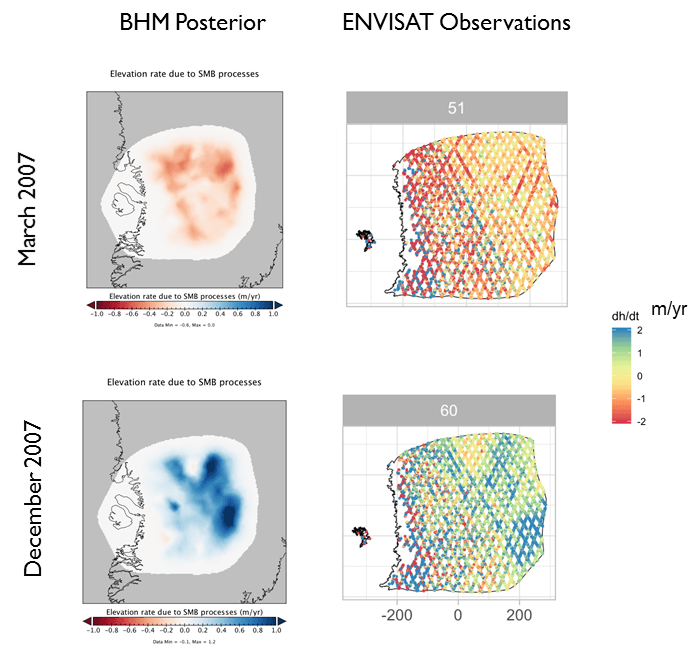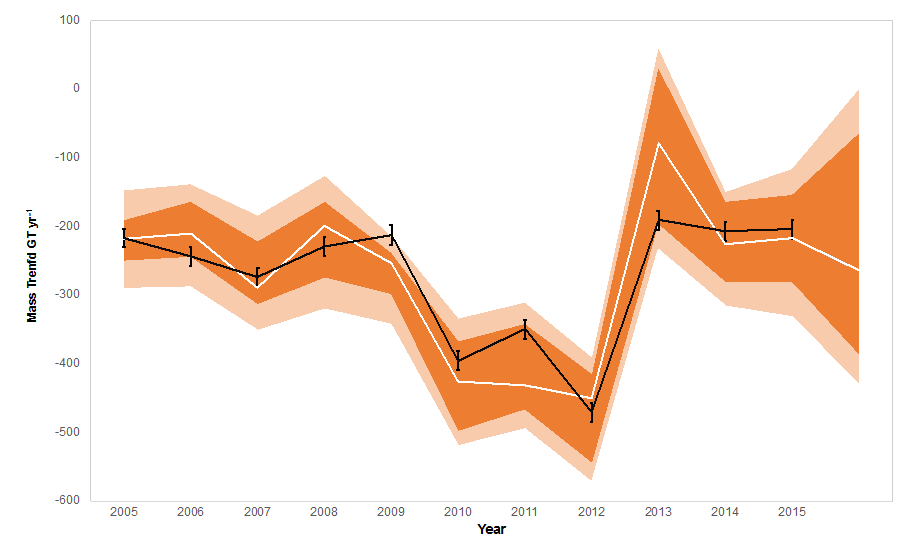Land ice
Progress (December 2019)
(a) Investigating ice mass trends for the Antarctic Peninsula using a BHM approach
A new and significant area of research during 2019 has been the application of a Bayesian Hierarchical Framework (BHM) to investigate ice mass trends for the Antarctic Peninsula. Understanding the mass balance of the Antarctic Peninsula is challenging for satellite-based observation techniques due to its mountainous topography with small outlet glaciers (meaning satellite altimeters lose precision), its geometry (on average 70km wide, significantly less than the 300km resolution of GRACE) and poor knowledge of its ice thickness (which is needed for calculations using the Input-Output Method). As a result, there is a large spread between results obtained from different methods (larger than can be explained by their individual stated errors), with GRACE studies alone suggesting a change in mass balance for the decade 2000 to 2010 that ranges from ~0 to -70 gigatons per year.
Deployment of a BHM framework has allowed us to combine a wide suite of different observational datasets, providing us with an opportunity to reconcile previous studies and to provide greater understanding of regional dynamics. Through the second half of 2019, we have constructed a BHM framework for the Antarctic Peninsula, building on what was done previously in the RATES project by using improved (i.e. higher spatial resolution) and new datasets.
Early results suggest that the different physical processes involved are being separated by the BHM in a sensible way. They also show that the increased spatial resolution of this work (compared to single trend values often provided, or even the relatively-coarse grid used in the RATES project) will likely give us new insight into the ice mass behaviour of the Peninsula.
During 2019, we also launched an online visualisation tool to allow users to interactively explore and download ice mass trend results obtained using our BHM methodology. Initially it contains data on Antarctic mass trends from 2003 to 2015, but we hope to extend the its functionality further to include more outputs from the GlobalMass project.

Figure 2: Our online visualisation tool
(b) New projections of future sea-level rise based on expert judgement
Following two workshops held in 2018, we published new projections of sea level rise from future melting of the Greenland, West Antarctic and East Antarctic ice sheets under low and high future global temperature rise scenarios. The potential contribution of ice sheets remains the largest uncertainty in projecting sea level rise beyond 2050 due to limitations in the predictive capability of numerical modelling. We used a technique called structured expert judgment (SEJ) to combine the individual estimates of 22 ice sheet experts. SEJ represents an alternative approach which provides a formal way of estimating uncertain quantities based on current scientific understanding.
Our projections of total global sea level rise include a small but meaningful (5%) probability of SLR exceeding two metres by the year 2100 under the high temperature scenario (roughly equivalent to “business as usual”) which is well above the ‘likely’ upper limit presented in the Fifth Assessment Report of the Intergovernmental Panel on Climate Change (IPCC).
The research was subsequently named in the Altmetric Top 100 list for 2019, marking it out as one of the most discussed and shared pieces of research published that year.
Progress (November 2018)
We reported on our first mass trend results for Greenland using a BHM approach earlier in the year but highlighted that the BHM was not allocating the total change correctly between the two main contributory processes, ice dynamics and surface mass balance.
This led us to re-think about how best to implement the BHM for Greenland, and ultimately to change from an annual to a monthly timestep. Since the surface mass balance has a strong seasonal cycle in Greenland (summer melt and winter accumulation), this provides us with a reliable way of separating it from the ice dynamic signal, which is far less influenced by season. It did, however, require a considerable amount of effort rewriting model code and reprocessing datasets. We were grateful to welcome project partner Dr Andrew Zammit-Mangion from University of Wollongong, Australia, to Bristol for a month during the autumn, who provided help with the implementation of the monthly timestep.
The new monthly set-up is being tested initially for a single basin, Jakobshaven Isbrae, and for a single year, 2007. Early results are encouraging (see figure below), and we hope to scale it up to the entire Greenland ice sheet for a longer time period in the coming months.

Predicted change in ice elevation due to surface mass balance (SMB) processes from the BHM (BHM posterior) compared to observed ice elevation change from the ENVISAT satellite for two months (March 2007 and December 2007).
In addition, and although not a central part of the GlobalMass project, in early 2018 we helped organise a structured expert judgement (SEJ) exercise to explore the current uncertainties in ice sheet contributions to sea level rise. The potential contribution of the ice sheets remains the largest uncertainty in projecting sea level rise beyond 2050 due to limitations in the predictive capability of numerical modelling approaches. SEJ represents an alternative approach which provides a formal approach for estimating uncertain quantities based on current scientific understanding. Two workshops were conducted to elicit estimated future ice sheet contributions for four time periods (2050, 2100, 2200, 2300) and two temperature scenarios for the Greenland, West Antarctic and East Antarctic ice sheets. A paper that provides full details of the approach and the results obtained is currently in review.
Progress (May 2018)
We have recently produced our first mass balance trends results for Greenland using the BHM framework. However, applying a method developed for Antarctica (in the RATES project) to Greenland has proved more complex than we anticipated. This is mainly because the nature of the processes that govern ice accumulation and melt are very different, requiring them to be incorporated differently and necessitating much code to be rewritten.

Figure 2. Comparison of our current BHM mass trend result (black line) with the weighted mean (white line) and range (orange bars) of other published studies
While the overall mass trend now appears sensible (and fits well against other published studies), a ‘source separation’ issue remains whereby the BHM is not allocating the total change correctly between the two main contributory processes, ice dynamics and surface mass balance. Work is ongoing to develop a method for better separating these processes and to therefore provide more robust results at both ice sheet and basin scales.
Progress (April 2018)
Considerable progress has been made with regards to using a BHM approach to understand ice mass trends for Antarctica and Greenland. Using a BHM framework allows us to produce statistically-rigorous estimates of ice sheet mass balance and the contribution of component parts at the drainage basin scale. Error-bounded estimates of Antarctic ice mass balance trends have now been obtained for 2003 to 2015 (an update of RATES project), and we have recently started to apply the BHM framework to explore mass balance trends for Greenland.
Next page: Outputs
